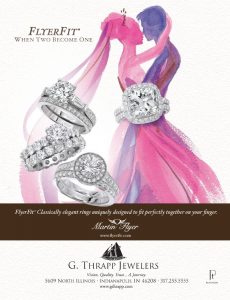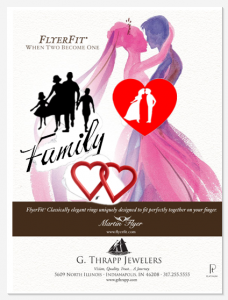Culture Jamming On a Wedding Ring Advertisement
The Original Advertisement:

the original ad
The exchange of wedding rings has been a universal practice across the globe in celebration of love and marriages for centuries; however, the practice of ring exchanging is no more than a representation of commitment and love.
Showing great business interest in the economic impact of the wedding ceremonies, ‘G. Thrapp Jewelers’ depicts a commercial image where the newly married couple is circled together by a sparkling ring to accentuate the materialistic importance of wedding rings; however, based on Shirley Ogletree’s research (2010), although women take weddings as a much serious business than men, neither women nor men think it is necessary to purchase expensive rings for their weddings. Overstating the importance of wedding rings, this advertisement is setting the consumption of diamond rings as the precondition for marriages. To be more specific, under the influence of capitalism and consumerism, this advertisement is expressing the idea that the size and the quantity of diamond rings are crucial factors that determine the formation of a new family. Not only just caged by one giant diamond ring, there are also three extra rings sitting next to the groom and the bride in the advertisement, and it is unjustifiably suggesting the idea that people’s desire for diamond rings is endless and it is always better to have more rings in one’s lifetime.
Clearly, this advertisement by ‘G. Thrapp Jewelers’ undervalues the importance of interpersonal connections. Ignoring the chemical attraction between couples; it is replacing the emotional aspects of marriages with materialistic factors. Based on the content of this advertisement, the social consumption of diamond rings indirectly implies a human sexuality bias, which is females engage in mating systems because they want to gain full access to male’s material resources and males are using their resources as a tool to spread their genes as far as possible. The jammed version of this advertisement attempts to criticize the potential consumerism behind it and remind people with the true meaning of marriages.
Bibliography:
Ogletree, S.M. (2010). With this Ring, I Thee Wed: Relating Gender Roles and Love Styles to Attitudes towards Engagement Rings and Weddings. Springer Science+Business Media, 27:67-77.
The Jammed Version of Advertisement:

the jammed version of the advertisement
The four diamond rings are reshaped into different pictures to target at consumerism and capitalism behind this advertisement by ‘G. Thrapp Jewelers’, namely, the wedding rings are altered into family pictures, interconnected heart shapes and kissing couples. Other than accentuating the materialistic importance of diamond rings in a wedding ceremony, the alternation I have applied in this advertisement attempts to shift the focus back to the real factors that lead to marriages.
Marriage, the result of meaningful commitment and interpersonal attraction, is not a way to maximize personal materialistic benefits. Changing the diamond ring that is tied around their waist into a heart-shaped picture where two individuals are passionately kissing, my intention is to restate the fact that people get married because of love rather than any other capitalistic reasons. The interlocked hearts at the bottom of this jammed advertisement strengthen the same viewpoint even further. Covering up the other two diamond rings in the corner, the darkened outline of a family unit on the left side of this advertisement is an ideal envision of the newly married couples’ future life. It indicates that shared responsibilities and hopes of building a future life together are also major contributors to the occurrence of marriages and weddings. Marriages take place under the assumption that two individuals love each other genuinely, and exchanging rings is no more than a simple practice in a wedding ceremony that happen as a representation of the two individual’s agreement on choosing each other as partners for the rest of their lives.
‘G. Thrapp Jewelers’ commercializes the meaning behind wedding rings, the original advertisement describes females as having insatiable appetite for diamond rings and encourages males to use diamond rings as a way to please their spouses. Through culture jamming and photo editing techniques, the new advertisement disagrees with capitalism and consumerism. It is trying to bring public attention to the false human sexuality bias, and to remind people of the emotional motivators and interpersonal factors behind marriages.